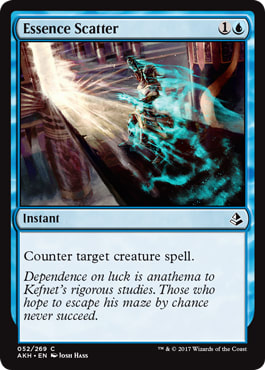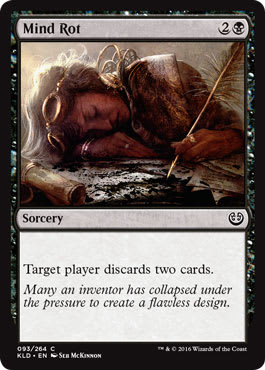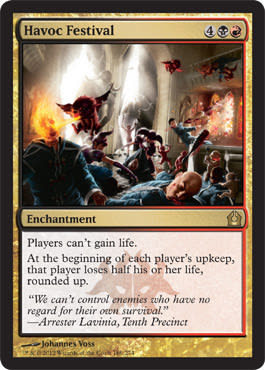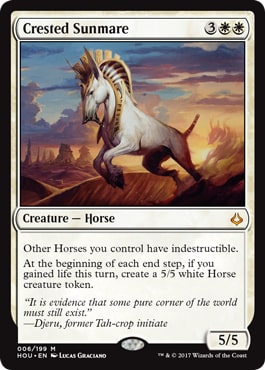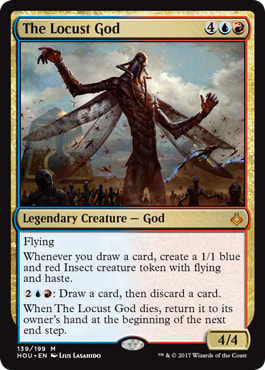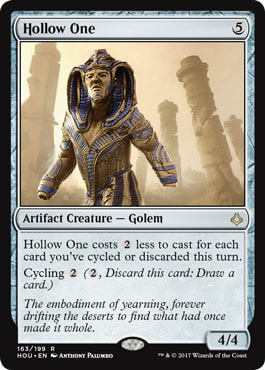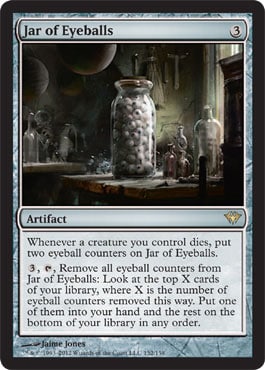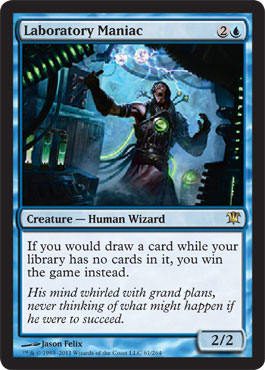— Victor Frankenstein
In Mary Shelley’s classic gothic novel, Frankenstein, a scientist becomes obsessed with generating life through unnatural means. He spends time, like all good scientists, conducting experiments. And if you know the story at all, you know one of them was successful . . . with monstrous results.
Like Victor Frankenstein (though perhaps a touch less crazy) my Magic group has recently been seized with the desire to experiment. We often play during the lunch hour at work, squeezing in quick head-to-head Commander matches, or 3-person Constructed games, during our short 60-minute lunchtime. But our Magic games had grown a little stale. We wanted to try something new.
So we decided to experiment with different ways to play the Sealed Deck Format. Like any good scientist, I’ve recorded our findings. Let’s see what awaits us at the end!

Frontispiece to the 1831 edition of Frankenstein.
EXPERIMENT #1 — AMONKHET SEALED
Our first experiment was fairly straight forward. A friend had purchased a box of Amonkhet booster packs. He gave each of 6 packs on the first week, then two packs every week that followed over the course of several weeks. This went on until all 36 booster packs had been handed out. We played 40-card decks most of the time, tweaking them a little bit each week. Near the end we increased the deck size to 60 cards.
Here’s the deck I ended up with:
Andy?s Sealed Deck ? Amonkhet Sealed | Andy Rogers
- Creatures (16)
- 1 Curator of Mysteries
- 1 Doomed Dissenter
- 1 Dread Wanderer
- 1 Festering Mummy
- 1 Lord of the Accursed
- 1 Shimmerscale Drake
- 1 Tah-Crop Skirmisher
- 2 Miasmic Mummy
- 2 Shadowstorm Vizier
- 2 Zenith Seeker
- 3 Wasteland Scorpion
- Planeswalkers (1)
- 1 Nissa, Steward of Elements
- Instants (8)
- 1 Censor
- 1 Final Reward
- 1 Hieroglyphic Illumination
- 2 Essence Scatter
- 3 Cancel
- Sorceries (5)
- 1 Benefaction of Rhonas
- 1 Dispossess
- 1 Lay Bare the Heart
- 1 Rags // Riches
- 1 Spring // Mind
- Enchantments (6)
- 1 As Foretold
- 1 Cartouche of Ambition
- 1 Trial of Knowledge
- 3 Cartouche of Knowledge
- Artifacts (1)
- 1 Edifice of Authority
- Lands (23)
- 2 Forest
- 8 Island
- 8 Swamp
- 1 Painted Bluffs
- 2 Evolving Wilds
- 2 Fetid Pools
- Sideboard (11)
- 1 Bontu's Monument
- 1 Cursed Minotaur
- 1 Embalmer's Tools
- 1 Festering Mummy
- 1 Final Reward
- 1 Gravedigger
- 1 Never // Return
- 1 Stir the Sands
- 2 Trespasser's Curse
- 1 Wander in Death
Some quick notes about this deck: It lost a lot. Wasteland Scorpion, Final Reward, and Essence Scatter were the best cards, bringing the most value for every situation they were in. many of the cycling-based combos just weren’t effective against my friends’ aggro decks. I never once got to cast As Foretold or Nissa, Steward of Elements since I opened them late in the experiment. That’s just the way the pyramid tumbles, sometimes.
Although this deck was disappointing, these sealed games were fun, if not a little too safe. Our card pools gave us a chance to see the plane of Amonkhet and it was fun to be immersed in a new setting, but the games quickly became humdrum. Our experiment took us at least 6 weeks to complete, and by the time we were done I think we were all ready for new decks.
The reason for this, I think, is because we didn’t trade cards very much. We tried — for the most part — to keep it a fairly straight-forward sealed experience: What you open, you open. And that was basically it. None of us were too keen to give up our bombs and rares, even if they were off-color and sitting in our sideboards.
We learned later that this was a significant flaw in our experiment.
EXPERIMENT #2 — THE RETURN TO RETURN TO RAVNICA
After the fairly dull games of the previous experiment, we decided to take the minotaur by the horns (as it were) and create our own Sealed Deck Format. One of my friends had recently purchased a box of Return to Ravnica boosters. So, as before, all three of us used one player’s cards for the experiment. But this time, we were open to the possibility of trading from our card pools.
One more difference from one experiment to the next, is that we moved to 60-card decks during the second week. The following list is the 60-card deck list I ended up with after 6 weeks:
Rakdos ? Return to Ravnica Sealed | Andy Rogers
- Creatures (23)
- 1 Bloodfray Giant
- 1 Carnival Hellsteed
- 1 Chaos Imps
- 1 Desecration Demon
- 1 Hellhole Flailer
- 1 Rakdos Ragemutt
- 1 Rix Maadi Guildmage
- 1 Thrill-Kill Assassin
- 2 Daggerdrome Imp
- 2 Grim Roustabout
- 2 Splatter Thug
- 2 Viashino Racketeer
- 3 Bellows Lizard
- 3 Rakdos Shred-Freak
- 1 Rakdos, Lord of Riots
- Instants (8)
- 2 Rakdos Charm
- 2 Ultimate Price
- 4 Auger Spree
- Sorceries (3)
- 1 Dreadbore
- 1 Mind Rot
- 1 Skull Rend
- Enchantments (3)
- 1 Havoc Festival
- 1 Racecourse Fury
- 1 Underworld Connections
- Lands (23)
- 9 Mountain
- 9 Swamp
- 1 Rogue's Passage
- 4 Rakdos Guildgate
- Sideboard (9)
- 2 Cremate
- 1 Explosive Impact
- 1 Grim Roustabout
- 1 Rakdos Cackler
- 1 Rakdos Ringleader
- 1 Slum Reaper
- 1 Spawn of Rix Maadi
- 1 Transguild Promenade
This was a fun deck to play! It won many of the matchups against other guilds. And even when it lost, it went down fighting. It played consistently and powerfully. Some specific thoughts:
Transguild Promenade might seem like a staple in a 2-color deck, but I found it to be way too slow, for our head-to-head games, or even our 3-player free-for-all games.
Mind Rot was surprisingly effective. It’s been in the game for so long that I’ve become blind to its power. It feels like filler because I already own so many copies from other sets, but it’s still an effective card. I put it in the sideboard originally, thinking I would only use it against an Azorius deck that won big with Righteous Authority. But I ended up keeping it in the main deck regardless of which guild I was playing against. It was a strong play every time.
I originally put Cremate in the sideboard for facing Golgari, though I ended up playing it in the main deck a few times just for the cantrip-like effect.
I was unimpressed with Rakdos Shred-Freak. It was great to cast it on turn two. But after that, it was a largely ineffective card. Its toughness is just too small. It died to stupid creatures like Concordia Pegasus, not to mention the army of 3/3 Centaur tokens I regularly faced when playing against a Selesnya deck. When I drew my second Rakdos Shred-Freak in a game I usually saved it as discard fodder for Viashino Racketeer.
Three or four games ended because of Havoc Festival. The big lesson about that card: If you have it — cast it! All you have to do is make sure your life total is just a little bit higher than your opponents’. Only once did it end up killing me before I could kill my opponents. The Rakdos Charm is a great surprise card that will drop your opponent’s life quickly (especially if they’re playing a token swarm deck). And the Daggerdrome Imps are really helpful for gaining those extra little bits of life you need to stay ahead. But mostly, Havoc Festival puts a clock on the game and it shuts down White and Green gain-life effects.
This deck lost to a Selesnya swarm deck more than any other guild. My Selesnya opponent typically played his deck in this order:
- Turn one: Centaur Herald
- Turn two: Call of the Conclave
- Turn three: Rootborn Defenses or Centaur Healer
- Turn four: Phantom General or Growing Ranks.
If you’re on the other side of the table when this sequence happens, you’re as good as dead. The 3/3 Centaur on turn two, followed by the Growing Ranks is just too powerful. I regularly played Ultimate Price on a turn-two token. That might seem like a waste of a good removal card, but when you’re facing an opponent running populate, it’s essential to keep tokens off the board. I even played Ultimate Price on a Centaur token when I could’ve chosen Phantom General, populate is just that strong.
As you can see from the notes, I enjoyed this sealed deck experiment much more than the first! Trading cards drastically altered our games. They were more competitive, less likely to get stuck in grindy battles with vanilla creatures, and just more fun. It felt like Magic again!
EXPERIMENT #3 — HOUR OF DEVASTATION
For experiment #3 we decided to try the Magic League format. This Sealed Deck Format was created by Wizards of the Coast. It’s meant to be a tool to teach new players how to play, and it is promoted to stores as a way to get new players in their area into the game (and presumably, into Standard).
Each player is given 3 packs of the new set and builds a 30-card deck. (You read that right. 30-card, not 40-card.) Over the course of the next 2-4 weeks, you play the same deck, adding cards from one new booster pack each week.
We decided to simulate this by purchasing a mix of packs from Amonkhet and Hour of Devastation. We made our 30-card decks from three packs. Over the next four weeks we added one Hour of Devastation booster pack per week.
By end of this experiment we had each opened a total of just 8 packs, and played the same deck multiple times. Here’s the 30-card deck I ended up with after 4 weeks of play:
Andy?s Sealed Deck ? Hour of Devastation Sealed League | Andy Rogers
- Creatures (11)
- 1 Bone Picker
- 1 Doomed Dissenter
- 1 Dune Beetle
- 1 Grim Strider
- 1 Hollow One
- 1 Lurching Rotbeast
- 1 Plague Belcher
- 1 Tenacious Hunter
- 1 Wasteland Scorpion
- 2 Defiant Greatmaw
- Instants (2)
- 1 Electrify
- 1 Without Weakness
- Sorceries (4)
- 1 Doomfall
- 1 Insult // Injury
- 1 Overcome
- 1 Unburden
- Enchantments (1)
- 1 Gift of Paradise
The first week was exciting! It was hard to build a 30-card deck that had any sort of synergy. Yet with such a small pool of cards it was easy to know what you would probably draw and plan your moves accordingly. (I felt like a madman from one of Kefnet’s crops, trying desperately to put all the pieces of a puzzle together.) Because we were playing multiplayer, I wasn’t too afraid of my opponent’s bombs (they only had three rares to spread among two opponents), however the -1/-1 counters that are prevalent in this block felt like a hard strategy to play in such small decks. The downsides were huge.
Getting only one pack during weeks 2-4 was kind of a letdown. I felt like my deck hardly changed after the first new pack. My rare was an off-color bomb (Crested Sunmare) making the most playable card from the new pack a 1-drop mana fixer.
I also wasn’t as excited about week 2 since I knew the other decks likely didn’t change much either. I easily remembered the big threats (one opponent had drawn The Locust God in his initial packs) and either I beat that creature or I lost the game.
As the weeks progressed our games were fun but stayed at a pretty low power level. After the speed and synergy of the Return to Ravnica games, the Magic League style of play felt clunky. Opening only 8 packs just felt really slow. All of us had off-color rares and uncommons that we didn’t use, which amounted to wasted cards.
One positive side effect of opening so few packs is that — more than ever — every pack counted! The thought of pulling a mythic rare, a Planeswalker, or — dare I say it — a Masterpiece was really exciting! Magic League makes every single pack a really big deal. (For the record, no one pulled a Masterpiece.)
The other positive about this tiny format is the in-world, flavorful experience it brings. As with the previous drafts, it felt like we were really visiting one plane in the Multiverse. It helps that both of my friends are part Vorthos. One of them even stays current with the lore, collects basic lands from every block, and is known to speak in a character’s voice when playing certain cards.
WHAT WE LEARNED FROM OUR SEALED EXPERIMENTS
1. Trading makes all the difference. Our games were much more competitive, much quicker, and much more fun when our decks were honed through trading.
This might seem counterintuitive to Sealed Deck Formats because the whole point in playing sealed games is to challenge yourself to build a winning deck out of the cards you have. However — at least for us — we found that when you’re playing the same poorly-honed deck week after week it gets a little old. But trading during our Return to Ravnica games re-ignited our interest in this experiment. It was easy (and even fun!) to trade away off-color bombs and Commander-esque rares to other players. Why keep them in your sealed pool if you’re not going to use them in your deck?
2. It’s really convenient when all of the cards belong to just one player. It makes trading more likely to happen.
During the Hour of Devastation games, I was hesitant to make any trades. I knew those packs would likely be the only packs I purchased from that set and wanted to hang on to every card. In retrospect, I was tying my own proverbial mummy in knots. I was limiting myself unnecessarily and causing slower, weaker games.
END STEP
Our experimentation continues with Ixalan. We plan to buy 10 packs each, open them all during the first week and build a 60-card deck. Then each week, for four weeks, we are free to add any one card from our collection at home. It can be any card from any set. The only requirement is that you tell the other players what card you are adding.
Ajani, Caller of the Pride? Yes, please. Taurean Mauler? You betcha. (Remember, these are 3-player games . . . ) Or, who knows, maybe Havoc Festival. It worked before! Either way, like Victor Frankenstein’s colossus, this next experiment promises to be monstrous!















